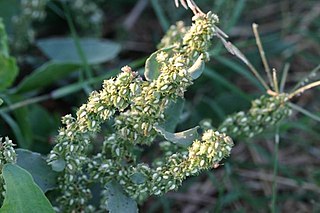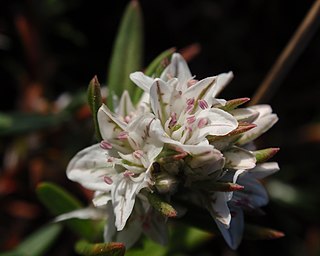
Berberis aquifolium, the Oregon grape or holly-leaved barberry, is a species of flowering plant in the family Berberidaceae, native to western North America. It is an evergreen shrub growing 1–3 meters tall and 1.5 m (5 ft) wide, with pinnate leaves consisting of spiny leaflets, and dense clusters of yellow flowers in early spring, followed by dark bluish-black berries.

Barbarea verna is a biennial herb in the family Brassicaceae. Common names include land cress, American cress, bank cress, black wood cress, Belle Isle cress, Bermuda cress, poor man's cabbage, early yellowrocket, early wintercress, scurvy cress, creasy greens, and upland cress. It is native to southern Europe and western Asia, and naturalized elsewhere It has been cultivated as a leaf vegetable in England since the 17th century. As it requires less water than watercress, it is easier to cultivate.

Maianthemum dilatatum is a common rhizomatous perennial flowering plant that is native to western North America from northern California to the Aleutian islands, and Asia across the Kamchatka Peninsula, Japan, and Korea. It grows in coastal temperate rainforests, and is often the dominant groundcover plant in Sitka Spruce forests.

Barbarea vulgaris, also called wintercress, or alternatively winter rocket, rocketcress, yellow rocketcress, yellow rocket, wound rocket, herb barbara, creases, or creasy greens, is a biennial herb of the genus Barbarea, belonging to the family Brassicaceae.

Momordica balsamina is a tendril-bearing annual vine native to the tropical regions of Africa, introduced and invasive in Asia, Australia, Central America, and North America, where they have been found in some parts of Florida. In 1810, Thomas Jefferson planted this vine in his flower borders at Monticello along with larkspur, poppies, and nutmeg.

Agastache rugosa, also known as wrinkled giant hyssop, Korean mint, purple giant hyssop, Indian mint and Chinese patchouli is an aromatic herb in the mint family, native to East Asia.

Cerastium glomeratum is a species of flowering plant in the family Caryophyllaceae known by the common names sticky mouse-ear chickweed and clammy chickweed. It is native to Europe, Macaronesia to Assam but is known on most continents as an introduced species. It grows in many types of habitat. The blooming period is February, March, April, and May.

Claytonia lanceolata is a species of wildflower in the family Montiaceae, known by the common names lanceleaf springbeauty and western springbeauty.

Erysimum cheiri, syn. Cheiranthus cheiri, the wallflower, is a species of flowering plant in the family Brassicaceae (Cruciferae), native to Greece, but widespread as an introduced species elsewhere. It is also treated as a hybrid under the name Erysimum × cheiri. It is widely cultivated as a garden plant.

Erythronium grandiflorum is a North American species of plants in the lily family. It is known by several common names, including yellow avalanche lily, glacier lily, and dogtooth fawn lily. The Ktunaxa name for glacier lily is maxa.

Prosartes trachycarpa, the roughfruit fairybells, rough-fruited fairybells or rough-fruited mandarin, is a North American species of plants in the lily family. The species is widespread, known from British Columbia to Ontario and south to Arizona and New Mexico. One isolated population was reported from Isle Royale in Lake Superior.

Antirrhinum filipes is an annual species of North American snapdragon, usually known by the common name yellow twining snapdragon. This herbaceous plant is native to deserts of the southwestern United States and northern Mexico, where it is common.

Cardamine oligosperma is a species of Cardamine known by the common name little western bittercress. It is native to western North America from Alaska to California to Colorado, where it grows in moist mountain habitats.

Carex disperma is a species of sedge known by the common names softleaf sedge or two-seed sedge. It is native to much of the northern Northern Hemisphere, from Alaska to Greenland, most of Canada and the contiguous United States, and across Eurasia.

Rumex stenophyllus is a species of flowering plant in the knotweed family known by the common name narrow-leaf dock. It is native to Eurasia and it can be found in parts of North America as an introduced species and roadside weed. It grows in moist and wet habitat, often in areas with saline soils. It is a perennial herb producing an erect stem from a thick taproot, usually measuring 40 to 80 centimeters tall, but known to well exceed one meter. The leaves are up to 30 centimeters long and are generally lance-shaped with curled edges. The inflorescence is an interrupted series of clusters of flowers with 20 to 25 in each cluster, each flower hanging from a pedicel. The flower has usually six tepals, the inner three of which are largest, triangular and edged with teeth, and bearing tubercles.

Polygonum paronychia is a species of flowering plant in the knotweed family known by the common names dune knotweed, black knotweed, and beach knotweed. It is native to the coastline of western North America from British Columbia to California, where it grows in sandy coastal habitat such as beaches, dunes, and scrub.

Bistorta bistortoides is a perennial herb in the buckwheat and knotweed family Polygonaceae. The species name remains unresolved.

Trautvetteria is a genus of flowering plants in the buttercup family. Today it is often considered a monotypic genus, containing only one species, Trautvetteria caroliniensis, which is known by the common names Carolina bugbane, false bugbane, and tassel-rue. A second species, T. japonica, is now generally considered a variety of this species. The genus is named for the botanist Ernst Rudolf von Trautvetter.

Vicia nigricans is a species of vetch known by the common name black vetch. It has a disjunct distribution, its two subspecies divided by thousands of miles in range. The northern subspecies, ssp. gigantea, is native to western North America from Alaska to northern California, where it occurs in coastal and moist inland habitat and disturbed areas. The southern subspecies, ssp. nigricans, occurs in southern South America, in Argentina and Chile.

Achyranthes japonica, commonly known as Oriental chaff flower or Japanese chaff flower, is a perennial member of the genus Achyranthes in the family Amaranthaceae. It can be discovered on the roadside and its main distribution is in Korea and Japan.





















